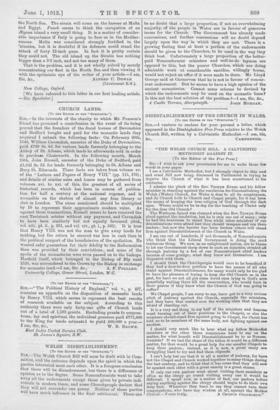CHURCH LANDS.
[TO THE EDITOR OP THE "SPECTATOR."] SIR,—In the interests of the charity to which Mr. Pearson's friend has promised a contribution in the event of its being proved that the founders of the ducal houses of Devonshire and Bedford bought and paid for the monastic lands they acquired I submit the following facts: On February 26th, 1540, William Cavendish, ancestor of the Duke of Devonshire, paid 2769 8s. 4d. for various lands formerly belonging to the Abbey of St. Albans, which lands he afterwards sold in order to purchase Chatsworth. In the following month, March 24th, John Russell, ancestor of the Duke of Bedford, paid £1,041 9s. 2d. for lands formerly belonging to St. Albans and Bury St. Edmunds. These facts are taken from volume xv. of the " Letters and Papers of Henry VIII." (pp. 115, 176) ; and details of similar sales and leases may be gathered from volumes xvi. to xxi. of this, the greatest of all series of historical records, which has been in course of publica- tion for half a century at the national expense, and is accessible on the shelves of almost any free library or :dub in London. The sums mentioned should be multiplied by 10 to represent their approximate modern value. As against these transactions, Russell seems to have received the vast Tavistock estates without any payment, and Cavendish to have been similarly but not equally favoured (ibid., vol. xiii., pt. ii., p. 281, and vol. xiv., pt. i., p. 585). It is true that Henry VIII. was not the man to give away lands for nothing, but the return he secured was less in cash than in the political support of the beneficiaries of the spoliation. He wanted safer guarantees for their fidelity to the Reformation than was provided by their convictions; and some of the spoils of the monasteries were even passed on to the bishops. Hatfield itself, which belonged to the Bishop of Ely until 1538, was surrendered to the Crown by the Bishop in exchange






































 Previous page
Previous page